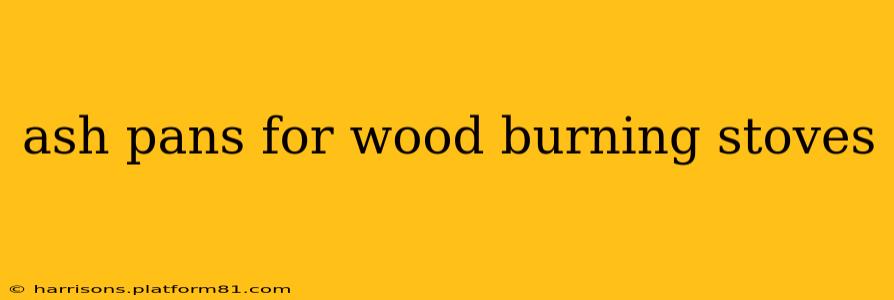Choosing the right ash pan for your wood-burning stove is crucial for efficient operation, safety, and ease of cleaning. This guide will delve into the various types, features, and considerations to help you select the perfect ash pan for your needs. We'll also answer some frequently asked questions to ensure you're fully informed before making your purchase.
What is an Ash Pan and Why Do I Need One?
An ash pan is a container located at the bottom of a wood-burning stove designed to collect ashes and embers. It's a vital component for several reasons:
- Fire Safety: An ash pan prevents hot embers from escaping and potentially causing a fire hazard. It contains the ash, keeping it away from flammable materials.
- Easy Cleaning: Instead of dealing with scattered ashes, you can simply remove the ash pan and dispose of the contents safely. This makes cleaning your stove significantly easier and less messy.
- Improved Airflow: A properly functioning ash pan helps maintain optimal airflow within the stove, leading to more efficient burning and less wasted fuel.
Different Types of Ash Pans for Wood Burning Stoves
Ash pans come in a variety of designs, materials, and sizes. Here are some common types:
- Removable Ash Pans: These are the most common type, easily pulled out from the stove for emptying. They are generally made of metal (steel or cast iron) and are relatively simple to use.
- Built-in Ash Pans: Some stoves have ash pans that are integrated into the stove's base. These are less easily removed but offer a more streamlined design.
- Ash Drawers: Similar to removable ash pans, ash drawers slide out, offering a more convenient emptying process compared to lifting a heavy pan.
The material of the ash pan also plays a role:
- Steel Ash Pans: Usually more affordable, steel ash pans are durable but can rust over time if not properly maintained.
- Cast Iron Ash Pans: These offer superior heat resistance and durability, often lasting much longer than steel pans, but they typically come at a higher price.
How Do I Choose the Right Ash Pan Size?
The size of your ash pan should be appropriate for your stove's size and usage. A pan that's too small will overflow quickly, while one that's too large might be cumbersome to handle. Always check the manufacturer's recommendations or consult with a specialist to determine the correct size for your specific stove model.
What Material is Best for an Ash Pan?
Both steel and cast iron are popular choices. Cast iron offers superior durability and heat resistance, making it ideal for frequent use and higher heat output stoves. Steel ash pans are more budget-friendly but may require more frequent replacements due to rust. The best choice depends on your budget and the intensity of your stove's use.
How Often Should I Empty My Ash Pan?
The frequency of emptying depends on how often you use your stove. As a general guideline, you should empty the ash pan whenever it is about half full. Never let the ash pan become completely full, as this can restrict airflow and hinder the stove's efficiency.
Can I Use a Different Ash Pan Than the One That Came With My Stove?
While it's generally recommended to use the ash pan that came with your stove, it may be possible to use a different one. However, ensure the replacement ash pan is the correct size and shape to fit your stove properly, maintaining proper airflow and safety. Incorrect sizing could lead to issues with burning efficiency or create a fire hazard. Always prioritize safety and confirm compatibility before using an alternative ash pan.
Where Can I Buy Replacement Ash Pans?
Replacement ash pans can typically be purchased from stove retailers, online marketplaces, or directly from the manufacturer of your stove. When ordering a replacement, always specify the make and model of your stove to ensure a proper fit.
By carefully considering these factors, you can select an ash pan that will contribute to the safe, efficient, and enjoyable use of your wood-burning stove for years to come. Remember to always consult your stove's manual for specific recommendations.
